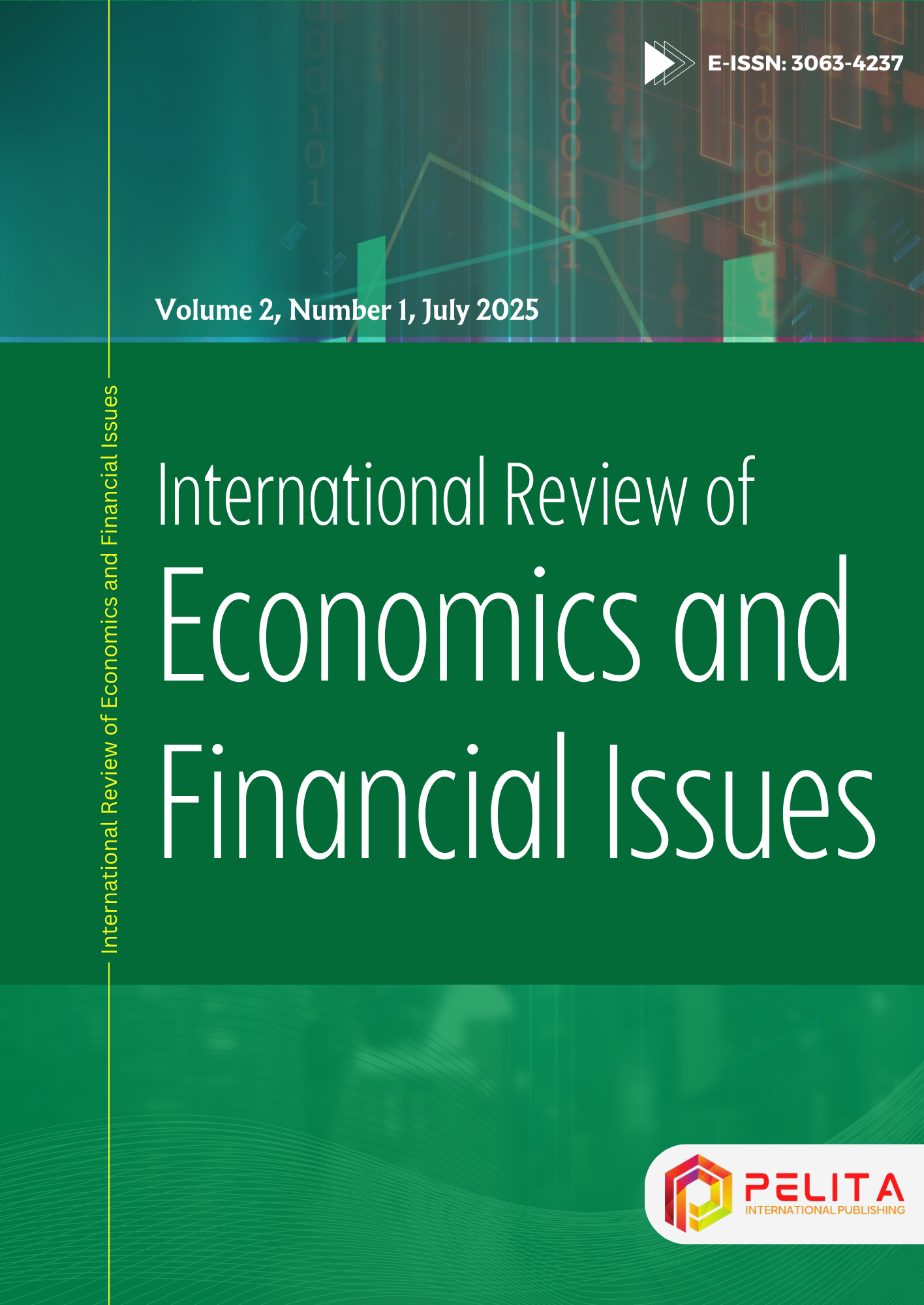How family planning and female labor force participation influence population growth in North Sumatra?
DOI:
10.62941/irefi.v2i1.40Downloads
Abstract
This study examines the impact of family planning programs and female workforce participation on population growth in North Sumatra, Indonesia. Understanding these factors is crucial for demographic policy and economic development. Using secondary time-series data from 2003 to 2022, this study employs multiple linear regression analysis to evaluate the relationships among the variables. The findings indicate that family planning programs have a positive but statistically insignificant effect on population growth, whereas female workforce participation has a positive and significant impact. Furthermore, both variables collectively have a significant influence on population growth. These results suggest that while family planning programs alone may not strongly affect population trends, the increasing participation of women in the workforce contributes notably to demographic changes. Policymakers should consider integrating employment and reproductive health policies to achieve sustainable population management.
Keywords:
Family planning programs female workforce participation population growth North SumatraReferences
Akhtar, R., Masud, M., & Rana, M. (2020). Labour force participation and nature of employment among women in selangor, malaysia. Environment and Urbanization Asia, 11(1), 123-139. https://doi.org/10.1177/0975425320906285
Amini, N., Suaedi, F., & Setijaningrum, E. (2024). The right prescription for family bliss: a cross-sectional study on community satisfaction in indonesian family planning programs. Social Sciences, 13(6), 325. https://doi.org/10.3390/socsci13060325
Ayaz, B., Martimianakis, M., Muntaner, C., & Nelson, S. (2021). Participation of women in the health workforce in the fragile and conflict-affected countries: a scoping review. Human Resources for Health, 19(1). https://doi.org/10.1186/s12960-021-00635-7
Bukhari, S., Malik, S., & Faridi, M. (2022). Role of education in poverty mitigation in pakistan: evidence from southern punjab. Pakistan Journal of Humanities and Social Sciences, 10(2). https://doi.org/10.52131/pjhss.2022.1002.0231
Cameron, L., Suarez, D. C., & Rowell, W. (2019). Female Labour Force Participation in Indonesia: Why Has it Stalled? Bulletin of Indonesian Economic Studies, 55(2), 157–192. https://doi.org/10.1080/00074918.2018.1530727
Frans, S., Cintyamena, U., Listyadewi, S., & Utomo, A. (2024). Women’s perspectives on post-partum family planning in banyumas, indonesia. Community Health Equity Research & Policy, 46(1), 103-115. https://doi.org/10.1177/2752535x241304080
Furtado, D. (2015). Can immigrants help women “have it all”? immigrant labor and women’s joint fertility and labor supply decisions. Iza Journal of Migration, 4(1). https://doi.org/10.1186/s40176-015-0043-x
Hasan, A. (2023). Impact of female labor force participation in economic development of pakistan. Reviews of Management Sciences, 5(1), 78-91. https://doi.org/10.53909/rms.05.01.0213
Hamity, M., Dillard, C., Bexell, S., & Graff-Hughey, C. (2019). A human rights approach to planning families. Social Change, 49(3), 469-492. https://doi.org/10.1177/0049085719863894
Hardee, K., Jurczynska, K., Sinaï, I., Boydell, V., Muhwezi, D., Gray, K., … & Wright, K. (2019). <p>improving voluntary, rights-based family planning: experience from Nigeria and Uganda. Open Access Journal of Contraception, 10, 55-67. https://doi.org/10.2147/oajc.s215945
Hatcher, V., Williams, M., Dorin, P., & Switzer, K. (2023). Catalyzing sustainable development: assessing the impact of family plan-ning programs on population control, reproductive health, and gender empowerment. LawEco, 17(2), 111-130. https://doi.org/10.35335/laweco.v17i2.4
Huriah, A., Syarief, S., & Hanum, N. (2025). The effect of population size, human development index, and workforce on poverty. International Review of Economics and Financial Issues, 1(3). https://doi.org/10.62941/irefi.v1i3.50
Hutchinson, P., Anaba, U., Abegunde, D., Okoh, M., Hewett, P., & Johansson, E. (2021). Understanding family planning outcomes in Northwestern Nigeria: analysis and modeling of social and behavior change factors. BMC Public Health, 21(1). https://doi.org/10.1186/s12889-021-11211-y
Idris, H. (2019). Factors affecting the use of contraceptive in indonesia: analysis from the national socioeconomic survey (susenas). Jurnal Kesehatan Masyarakat, 15(1), 117-123. https://doi.org/10.15294/kemas.v15i1.14098
Klasen, S. (2019). What explains uneven female labor force participation levels and trends in developing countries?. The World Bank Research Observer, 34(2), 161-197. https://doi.org/10.1093/wbro/lkz005
Masilo, M. (2022). Panoramas of regulating the right to reproductive health: a remedy to socio-economic challenges in south africa. Journal of Educational and Social Research, 12(3), 162-171. https://doi.org/10.36941/jesr-2022-0075
Mollet, J. and Mollet, G. (2024). Population and development: employing the capability approach in family planning policy for women in indonesia. International Journal of Applied Business and International Management, 9(1), 120-135. https://doi.org/10.32535/ijabim.v9i1.2917
Nazah, N., Duasa, J., & Arifin, M. (2021). Fertility and female labor force participation in asian countries; panel ardl approach. Jurnal Ekonomi & Studi Pembangunan, 22(2), 272-288. https://doi.org/10.18196/jesp.v22i2.11142
Paul, R. and Goswami, A. (2022). Participation of women in the workforce: a comparative study between central and western plains of west bengal. South Asian Journal of Social Studies and Economics, 81-88. https://doi.org/10.9734/sajsse/2022/v16i4623
Paul, R., Goswami, A., & Pal, B. (2023). Effect of socio-economic aspects on women work force participation level in west bengal, india. Asian Journal of Agricultural Extension Economics & Sociology, 41(10), 277-288. https://doi.org/10.9734/ajaees/2023/v41i102169
Raharja, M., Fadila, W., & Rahmadewi, R. (2021). Fertility in north sumatera: why is it not declining?. Jurnal Kesehatan Masyarakat, 16(3), 385-393. https://doi.org/10.15294/kemas.v16i3.26138
Rochaida, E. (2016). Dampak pertumbuhan penduduk terhadap pertumbuhan ekonomi dan keluarga sejahtera di Provinsi Kalimantan Timur. Forum Ekonomi: Jurnal Ekonomi, Manajemen dan Akuntansi, 18(1), 14-24. https://doi.org/10.30872/jfor.v18i1.42
Tumangger, H. N., Mardhani, M., & Iskandar. (2024). The impact of demographic variables on economic growth in North Sumatra, Indonesia. International Journal of Advances in Social Sciences, 1(1), 9–14. https://doi.org/10.62941/ijass.v1i1.5
Utomo, B., Rahayu, S., Liyanto, E., Romadlona, N. A., Nuryana, D., Aryanty, R. I., ... & Magnani, R. (2025). The Indonesian national family planning program: progress and remaining challenges in implementing a rights-based approach. International Journal of Human Rights in Healthcare, 18(1), 1-16.
Utomo, B., Sucahya, P., Romadlona, N., Robertson, A., Aryanty, R., & Magnani, R. (2021). The impact of family planning on maternal mortality in indonesia: what future contribution can be expected?. Population Health Metrics, 19(1). https://doi.org/10.1186/s12963-020-00245-w
Vu, L., Tran, T., & Phung, T. (2021). Children and female labor market outcomes in vietnam. Heliyon, 7(7), e07508. https://doi.org/10.1016/j.heliyon.2021.e07508
Wicaksono, P., Ferezagia, D., & Filardi, M. (2024). Gender and global production network: de-feminization of the indonesian apparel industry. Journal of Social Economics Research, 11(2), 175-187. https://doi.org/10.18488/35.v11i2.3655
Zaen, N. (2022). The relationship between age, education level, and residential area towards contraceptive use in married women in indonesia. Jurnal Biometrika Dan Kependudukan, 11(1), 1-10. https://doi.org/10.20473/jbk.v11i1.2022.1-10
Zhao, Y., Zhang, L., Lu, Y., & Wen, B. (2023). More rights but less gains: relaxed birth control policy and the loss for women. China & World Economy, 31(2), 159-191. https://doi.org/10.1111/cwe.12454
License
Copyright (c) 2025 Nurul Chotimah, Nurlina, Asnidar

This work is licensed under a Creative Commons Attribution 4.0 International License.
You are free to:
- Share — copy and redistribute the material in any medium or format for any purpose, even commercially.
- Adapt — remix, transform, and build upon the material for any purpose, even commercially.
The licensor cannot revoke these freedoms as long as you follow the license terms.
Under the following terms:
- Attribution — You must give appropriate credit, provide a link to the license, and indicate if changes were made. You may do so in any reasonable manner, but not in any way that suggests the licensor endorses you or your use.
- No additional restrictions — You may not apply legal terms or technological measures that legally restrict others from doing anything the license permits.
Notices:
You do not have to comply with the license for elements of the material in the public domain or where your use is permitted by an applicable exception or limitation.
No warranties are given. The license may not give you all of the permissions necessary for your intended use. For example, other rights such as publicity, privacy, or moral rights may limit how you use the material.






